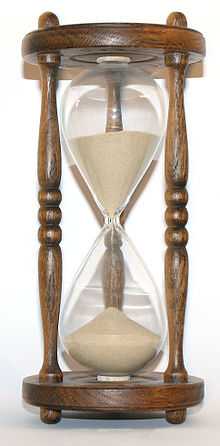Minute
This article is about the unit of time, angle and right ascension.
For the written record of a meeting, see
Minutes.
For other uses of the word, see
Minute (disambiguation).
The minute is a unit of time or of angle. As a unit of time, the minute is equal to 1⁄60 (the first sexagesimal fraction[1]) of an hour or 60 seconds. In the UTC time standard, a minute on rare occasions has 59 or 61 seconds, a consequence of leap seconds. As a unit of angle, the minute of arc is equal to 1⁄60 of a degree or 60 seconds (of arc). Although not an SI unit for either time or angle, the minute is accepted for use with SI units for both.[2] The SI symbols for minute or minutes are min for time measurement, and the prime symbol after a number, e.g. 5′, for angle measurement. The prime is also sometimes used informally to denote minutes of time.
Astronomy
Unit of right ascension
In astronomy, the minute is a unit of angle, the minute of right ascension. It is equal to 1⁄60 of an hour of right ascension and can be further divided into 60 seconds of right ascension.
The Earth turns on its polar axis through fifteen minutes of arc in every minute of sidereal time. One minute of arc at the Earth's equator is approximately one nautical mile.
Planetary motion
In old astronomical texts, minute can also mean a unit of time equal to 1⁄60 of a day (24 usual minutes). These minutes correspond to the Latin diei scrupulis, and used to express periods of planetary motions. For example, Kepler in Harmonices Mundi gives Saturn's year as 10759D12', that is 10759 (Earth) days, 4 hours, and 48 (usual) minutes (roughly 29.5 years).
See also
Notes and references
Bibliography

